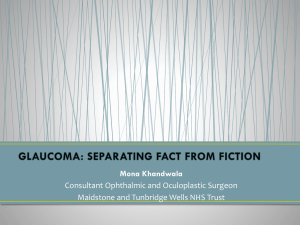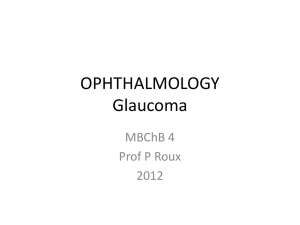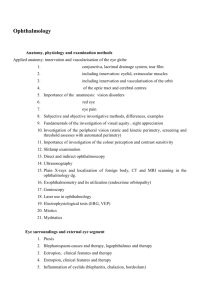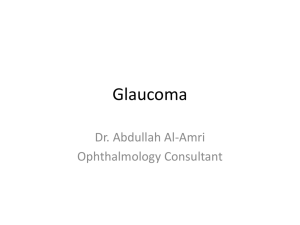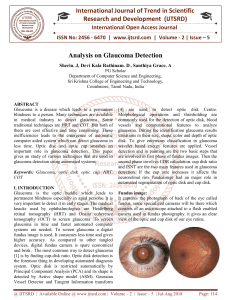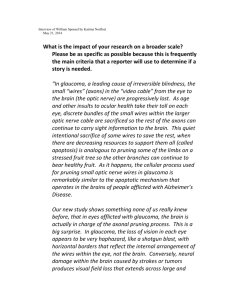The Diagnostic Conundrums of Glaucoma
advertisement
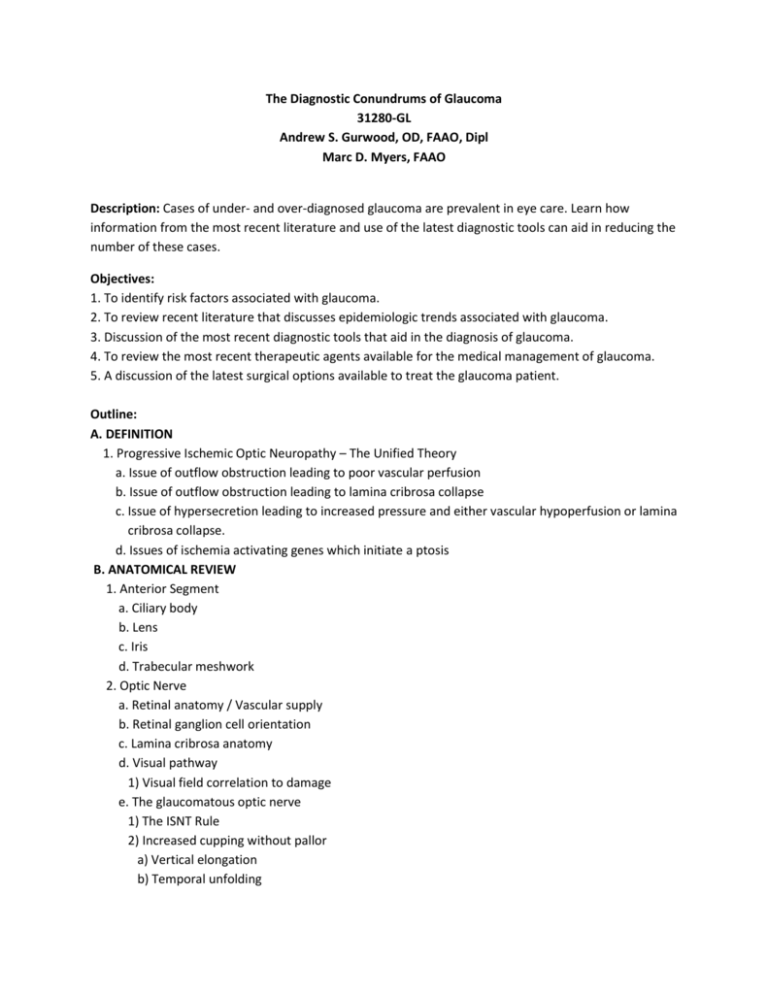
The Diagnostic Conundrums of Glaucoma 31280-GL Andrew S. Gurwood, OD, FAAO, Dipl Marc D. Myers, FAAO Description: Cases of under- and over-diagnosed glaucoma are prevalent in eye care. Learn how information from the most recent literature and use of the latest diagnostic tools can aid in reducing the number of these cases. Objectives: 1. To identify risk factors associated with glaucoma. 2. To review recent literature that discusses epidemiologic trends associated with glaucoma. 3. Discussion of the most recent diagnostic tools that aid in the diagnosis of glaucoma. 4. To review the most recent therapeutic agents available for the medical management of glaucoma. 5. A discussion of the latest surgical options available to treat the glaucoma patient. Outline: A. DEFINITION 1. Progressive Ischemic Optic Neuropathy – The Unified Theory a. Issue of outflow obstruction leading to poor vascular perfusion b. Issue of outflow obstruction leading to lamina cribrosa collapse c. Issue of hypersecretion leading to increased pressure and either vascular hypoperfusion or lamina cribrosa collapse. d. Issues of ischemia activating genes which initiate a ptosis B. ANATOMICAL REVIEW 1. Anterior Segment a. Ciliary body b. Lens c. Iris d. Trabecular meshwork 2. Optic Nerve a. Retinal anatomy / Vascular supply b. Retinal ganglion cell orientation c. Lamina cribrosa anatomy d. Visual pathway 1) Visual field correlation to damage e. The glaucomatous optic nerve 1) The ISNT Rule 2) Increased cupping without pallor a) Vertical elongation b) Temporal unfolding c) Notching d) NFL drop out e) Baring of circumlimbal vessels f. Imposters 1) Coloboma 2) Optic pit 3) Hypoplastic disc 4) Congenital enlarged cupping 5) Hypovolemic optic neuropathy 6) Disc at risk / Drusen – visual field loss without cupping 7) ION 8) CRVO 9) CRAO 10) CVA C. CLASSIFICATION 1. Primary open angle glaucoma - Gonioscopy 2. Secondary open angle glaucoma - Gonioscopy a. Pigment dispersion b. Pseudoexfoliation c. Late glaucoma / Traumatic / Angle recession d. ICE syndromes e. Increased episcleral venous pressure 1) Phacometers 2) C.S. fistula 3) Familial tortuous conjunctival vessels with increased episcleral venous pressure f. Inflammation 3. Primary closed angle glaucoma (pupil block) a. Primary pupil block b. Pseudophakic pupil block c. AQ misdirection 4. Secondary closed angle glaucoma a. Plateau iris b. Neovascular c. Uveitic (synechiae closure) d. Tumor D. DIAGNOSIS 1. History a. Family history of glaucoma b. Social history – risk factors c. History of present illness – r/o vascular disease, r/o migraine, baseline B.P. pulse d. History of previous illness / trauma e. History of medicine use (steroids for asthma, etc.) f. History of ocular disease / Illness g. Genes : GLC1 – A, GLC1 – F, OPTN, MYOC, TIGR, CYB1P1 2. Visual acuity / Pin hole 3. Pupils 4. Confrontation visual fields 5. Biomicroscopy a. Anterior segment assessment 1) Cornea 2) A/C depth 3) Angles 4) Iris 5) Lens b. Tonometry c. Gonioscopy 6. Pachymetry 7. DFE 8. Visual Fields a. Standard automated visual field testing (24-2) (30-2) – Strategies, e.g., Sita and interpretation b. Standard automated perimetry – Blue yellow c. F.D.P. d. Goldmann e. Tangent screen 9. GDX 10. HRT 11. Correlation / Repeatability / Reliability / Fragility – To treat or not to treat 12. Record keeping E. TREATMENT 1. Topical Medical Therapy a. Beta Blockers 1) Timoptic 2) Betagan 3) Betoptic 4) Optipranolol 5) Ocupress 6) Betimol b. Alpha Adrenergics 1) Alphagan - P c. Prostaglandin Analogs 1) Travatan 2) Xalatan 3) Lummigan 4) Rescula d. Carbonic Anhydrase Inhibitors 1) Azopt 2) Trusopt e. Topical Glycerin (Ophthalgan) f. Combinations 1) Cosopt 2) Combigan 3) Xalcom g. Cholinergic medications 1) Pilocarpine and company 2. Oral Medical Therapy a. Diamox b. Neptazane c. Glycerine 3. Surgical Management a. Laser Procedures 1) ALT 2) SLT 3) Laser cyclocrotherapy b. Trabeculectomy 1) Filtering bleb c. Seton 1) Krupin 2) Beverveldt 3) Molteno 4) Achmed d. Cyclocryotherapy F. ADDING MEDICATIONS TO EXISTING THERAPY 1. Fragility 2. Repeatability 3. Correlation 4. Flux or rate of change G. THE STUDIES 1. EMGT 2. OHTS 3. GLTS 4. AGIS 5. CIGTS a. 5 fu Study b. MMC Study




